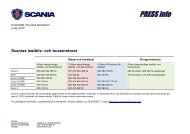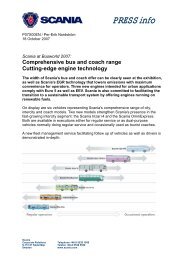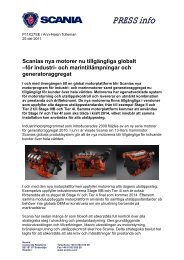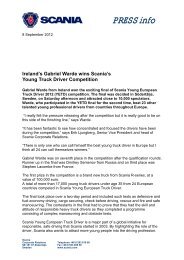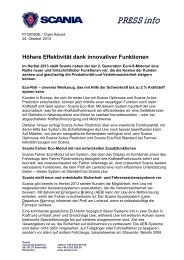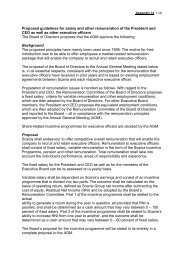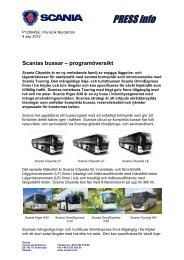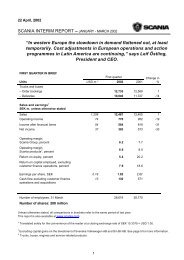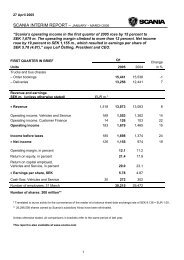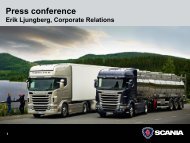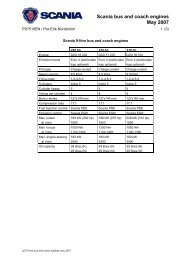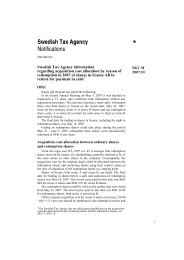Scania Annual Report 2011
Scania Annual Report 2011
Scania Annual Report 2011
You also want an ePaper? Increase the reach of your titles
YUMPU automatically turns print PDFs into web optimized ePapers that Google loves.
132<br />
notes to the consolidated financial statements<br />
NOTE 31 Financial instruments<br />
Financial assets in the <strong>Scania</strong> Group mainly consist of financial leases<br />
and hire purchase receivables that have arisen in the Financial Service s<br />
segment due to financing of customers’ vehicle purchases. Other<br />
financia l assets of significance are trade receivables from independent<br />
dealerships and end customers in the Vehicles and Services segment<br />
plus short-term investments and cash and cash equivalents. <strong>Scania</strong>’s<br />
financial liabilities consist largely of loans, mainly taken out to fund<br />
Financia l Service s’ lending and leasing to customers and, to a lesser<br />
exten t, to fund capital employed in Vehicles and Services. Financial<br />
assets and liabilities give rise to various kinds of risks, which are largely<br />
managed by means of various derivative instruments. <strong>Scania</strong> uses<br />
derivative instruments, mainly for the purpose of:<br />
– Transforming corporate-level borrowings in a limited number of<br />
currencies to the currencies in which the financed assets are<br />
denominated.<br />
– Transforming the interest rate refixing period for borrowings in<br />
Financial Services as well as achieving the desired interest rate<br />
refixing period for other borrowings.<br />
– Converting future commercial payments to functional currency.<br />
– To a lesser extent, converting surplus liquidity in foreign currencies<br />
to SEK.<br />
For financial instruments that are carried at accrued cost, fair value<br />
disclosures are provided in the table below. The carrying amounts of<br />
interest-bearing assets and liabilities in the balance sheet may diverge<br />
from their fair value, among other things as a consequence of changes<br />
in market interest rates. To establish the fair value of financial assets<br />
and liabilities, official market quotations have been used for those<br />
asset s and liabilities that are traded in an active market.<br />
In those cases where assets and liabilities are not traded in an<br />
active market, fair value has been established by discounting future<br />
payment flows at current market interest rates and then converting to<br />
SEK at the current exchange rate.<br />
Fair value of financial instruments such as trade receivables, trade<br />
payables and other non-interest-bearing financial assets and liabilities<br />
that are recognised at accrued cost minus any impairment losses, is<br />
regarded as coinciding with the carrying amount.<br />
Impairment losses on assets occur only when there is reason to<br />
believe that the counterparty will not fulfill its contractual obligations,<br />
not as a consequence of changes in market interest rates.<br />
FAIR VALUE OF FINANCIAL INSTRUMENTS<br />
In <strong>Scania</strong>’s balance sheet, items carried at fair value are mainly<br />
derivatives and current investments. For derivatives for which hedge<br />
accounting is not applied and certain current investments, fair value<br />
adjustment is carried via the income statement. Derivatives attributable<br />
to cash flow hedging are carried at fair value via “Other comprehensive<br />
income”. Fair value is established according to various levels,<br />
defined in IFRS 7, that reflect the extent to which market values have<br />
been utilise d. Current investments and cash and cash equivalents<br />
are carrie d according to Level 1, i.e. quoted prices in active markets<br />
for identical assets, and amounted to SEK 1,192 m. (1,047, –). Other<br />
assets that are carried at fair value refer to derivatives. These assets<br />
are carrie d according to Level 2, which is based on data other than the<br />
quoted prices that are part of Level 1 and refer to directly or indirectly<br />
observable market data. These items are carried under other noncurrent<br />
assets, other current assets, other non-current liabilities and<br />
other current liabilities and amounted to SEK 545 m. (1,106, –259) net.<br />
financial reports <strong>Scania</strong> <strong>2011</strong>



